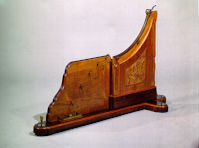
80 x 130 x 47
Carved wood, brass and copper
INDEX 1788 : G.IV.178
Machina lignea, qua ostenditur corpora secundum horizontem projecta ferri in linea parabolica, dum annulos quinque in hac curva dispositus pertranseunt.
A machine made of wood that shows that bodies projected along the horizontal follow a parabolic line while passing through five rings arranged on this curve.
In order to illustrate the parabolic trajectory described by a projectile this machine, comprising two wooden plaforms fixed to a horizontal base, is used. The periphery of one of the platforms has the shape of a circular arc, that serves to support a channel limited laterally by two brass blades. On the other platform there are five rings, each of 6 cm in diameter, placed along the arc of a parabola.
A sphere, released from the highest point of the circular trajectory, continues its course to the end of its channel, then describes a parabolic trajectory in space that passes through the inside of the circular rings. The sphere is set in motion by moving a little jointed piece of brass installed in the upper end of the channel.
In order to mount correctly the circular rings on the parabola described by the sphere, the position of its point of impact on a brass box placed at the base of the apparatus had to be determined beforehand. Then the length of the horizontal segment of straight line was measured, defined by the point of impact, and by the point on the base at the intersection of the vertical that passes through the lower end of the channel. This distance was divided into n + 1 equal parts, n being the number of rings that were to be mounted. Vertical lines were made to pass through the points of this division and intervals marked on them, from top to bottom, according to the sequence defined by the general term (n + 1)2, from n = 0, starting from the point where the sphere began its projectile movement,
The composition of velocities, for the case of uniform accelerated movement, was illustrated by Nollet with an apparatus similar to the one displayed here; for the illustration of uniform movement he used an instrument similar to n.º 51.
From Colégio dos Nobres, catalogue n.º 168.'s Gravesande, Willem Jacob, Physices Elementa, Leiden, 1742, vol. I, p. 543, Tab. XIX, Fig. 3.
Desaguliers, Jean-Théophile, A Course of Experimental Philosophy, London, 1734, Lesson V, Pl. 24, Figs. 2-5.
Nollet, Jean-Antoine, Leçons de Physique Expérimentale, Paris, 1764, Tomo II, Leçon V, P1. 3, Fig. 11.